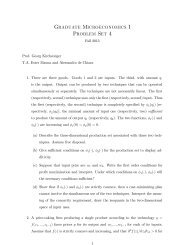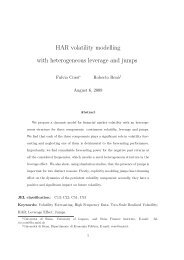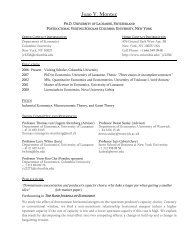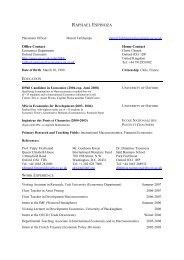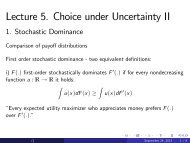Switching Costs in Two-sided Markets - Ecares
Switching Costs in Two-sided Markets - Ecares
Switching Costs in Two-sided Markets - Ecares
- No tags were found...
You also want an ePaper? Increase the reach of your titles
YUMPU automatically turns print PDFs into web optimized ePapers that Google loves.
3.6 Heterogeneous ConsumersI now turn to discuss, rather than hav<strong>in</strong>g all consumers be<strong>in</strong>g rational or be<strong>in</strong>g naive,the consequences of hav<strong>in</strong>g heterogeneous consumers on each side, where a proportion α iof side-i consumers are myopic, while 1−α i of them are forward-look<strong>in</strong>g. Differentiat<strong>in</strong>gEquation (3) with respect to α i , α j and δ F , we obta<strong>in</strong> the follow<strong>in</strong>g:Proposition 6. In the two-period two-<strong>sided</strong> s<strong>in</strong>gle-hom<strong>in</strong>g duopoly model, where oneach side a fraction α i of the consumers are naive, while 1 − α i of them are rational; µ iconsumers are loyal, while the rema<strong>in</strong><strong>in</strong>g ones have <strong>in</strong>dependent preferences,i. p i 0,1 is decreas<strong>in</strong>g <strong>in</strong> α i if µ i is close to 1.ii. p i 0,1 is <strong>in</strong>creas<strong>in</strong>g <strong>in</strong> α j.iii. p i 0,1 is decreas<strong>in</strong>g <strong>in</strong> δ F .See Appendix D for the proof.The <strong>in</strong>tuition beh<strong>in</strong>d this proposition is as follows. (i) shows that hav<strong>in</strong>g morenaive consumers on one side lowers the price of this side if this side conta<strong>in</strong>s manyloyal consumers. The reason for this is that when all consumers of this side are loyal(µ i = 1), they know that once they have purchased they will be locked-<strong>in</strong> with thesame platform forever, and thus have to be offered a bigger carrot <strong>in</strong> the first period.Moreover, naive consumers, who care only about today, are more attracted by a currentprice cut. Therefore, an <strong>in</strong>crease <strong>in</strong> loyal and naive consumers provides more <strong>in</strong>centivesfor platforms to compete aggressively. (ii) shows that hav<strong>in</strong>g more naive consumers onone side will <strong>in</strong>crease the price of the other side. Intuitively, smaller marg<strong>in</strong>s to conv<strong>in</strong>cethe myopic consumers on one side to jo<strong>in</strong> the platform must be recouped through largermarg<strong>in</strong>s on the other side. This type of unbalanced price structure is common <strong>in</strong> two<strong>sided</strong>markets. (iii) <strong>in</strong>dicates that equilibrium prices are lower when the platforms aremore patient. The <strong>in</strong>tuition is that firms compete harder on prices because they foreseethe advantage of hav<strong>in</strong>g a large customer base <strong>in</strong> the next period.3.7 Effect of switch<strong>in</strong>g costs on first-period profitIn equilibrium,π 0 = 1 2 pA 0,1 + 1 2 pB 0,1 + δπ 0,2 .Thus,∂π 0= 1 ∂p A 0,1+ 1 ∂p B 0,1∂s i 2 ∂s i 2 ∂s ibecause π 0,2 are not affected by s i <strong>in</strong> equilibrium.As is well-known from the switch<strong>in</strong>g-cost literature, switch<strong>in</strong>g costs raise platforms’profits <strong>in</strong> the second period as prices are usually higher. However, the presence of marketpower over the locked-<strong>in</strong> consumers <strong>in</strong>tensifies competition <strong>in</strong> the first period, and this15








